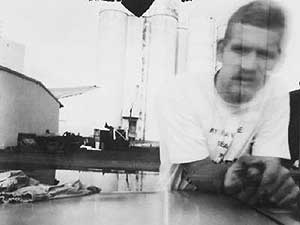|
Audio
Photos
Resources
Your Voice
|
Cameras made from cardboard
August 16, 2004
 |
| Derrick Burbul shot this photograph of himself with a pinhole camera -- little more than a carboard box sealed with duct tape. (Submitted by Derrick Burbul) |
Duluth, Minn. — Burbul's pictures are hanging on the walls in the depot's balcony. Next to each photograph is a letter written by the person who shot the picture, and below each one there's a little shelf holding a battered cardboard box covered in duct tape.
 | |||
Those are the cameras.
"A pinhole camera can be anything, pretty much, as long as it's light-tight space," Burbul says.
The towering atrium here at the depot could become a pinhole camera.
"You black out all these windows and then just put a small aperture somewhere, a small hole in one of these windows," Burbul says. "You could stand back, and eventually your eyes would adjust and you could see the image that's being projected from the outside." His cameras work the same way -- on a smaller scale. Most of them are about the size of a shoebox.
 | |||
"We can take a look," he says, and grabs one of the cameras from its shelf. He pulls off some of the duct tape and opens the box.
It's low-tech indeed. The inside of the box is painted jet black. A couple strips of tape are stuck to one of the inside walls; that's where Burbul fastened a piece of film. On the opposite side he punched a tiny hole to shed light on the film. He covered the hole with a flap of cardboard. All the photographer had to do was point the camera, remove the flap, put the flap back, and mail the camera back to Burbul.
The mailing address and postage stamps are stuck on the outside of the box.
"On the back here I have the guidelines for exposing the camera," he says, turning the box over in his hands. "Bright and hazy on sand or snow, 10 seconds. Heavy overcast, five minutes. Brightly-lit city scene, 50 minutes. Brightly-lit interior, 45 minutes. And you don't have the viewfinder. You don't know exactly what's going to be in this image. You kind of point it there, and you hope."
About six years ago, Derrick Burbul started dropping these boxes in the mail. He's sent about 75, and a third of them have come back. He opens them up in a darkroom and develops the film and prints the photographs. About two dozen of them are hanging on the walls here in Duluth.
 | |||
"Probably half this work is people that I do know on some level," he says. "The other half is maybe just mere acquaintances, or friends of friends, or something like that."
He's gotten pinhole cameras back in the mail from Maine and from northern Minnesota, from Japan, Norway, and from Lesotho in southern Africa.
"Recently I got my first camera from a non-American," he says. His in-laws took a trip to El Salvador, so he gave them a camera and asked them to give it to someone they met.
"So I got an image from El Salvador," Burbul says. "it's right here. She's Ana Guadalupe Ramirez Solada in Los Heros, El Salvador."
The black and white photograph shows the interior of a small room. The picture is clearly focused except for the blurry image of a person in the middle of the frame. This photograph was probably exposed for 20 minutes, and Ana Solada must have moved during that time. Derrick Burbul likes the blurriness in pinhole photos. And he likes the window these pictures give him into other people's lives.
"It's an image of her in her home," he says, looking at the picture from El Salvador. "You can see that there's no door on there. And it's not a very big place. She's sitting in the middle of this composition. She must have set it on her bed there. You can see these sheets in the foreground, and there's one bare light bulb hanging from the ceiling there, and she's sitting below that light bulb."
|
I'm always excited to get letters or things from people in the mail.
- Photographer Derrick Burbul |
Some of the pictures are fuzzier than this one. Some are sharp. Some are indoors, some outdoors. And they all have stories. Like, "This is the place I buried my dog," or, "This is the creek where I stole my husband's clothes while he was skinny-dipping."
Derrick Burbul likes the stories as much as the pictures. And he likes that this project is full of surprises -- for him and for his collaborators.
"I'm always excited to get letters or things from people in the mail," he says. "You get a package, even if you ordered something, it's kind of exciting, isn't it? You're like, oooh! You know what's in there, but you're excited about it. You're like, what's in the box? Oh, it's the thing I ordered. All right!"
Derrick Burbul is still sending out pinhole cameras -- about one a month. He's thinking about collecting the photographs and stories in a book some day. For now, the photographs, stories and pinhole cameras are on display at Duluth Art Institute's gallery in the Depot in Duluth. They'll be there through October.
|
News Headlines
|
Related Subjects
|
